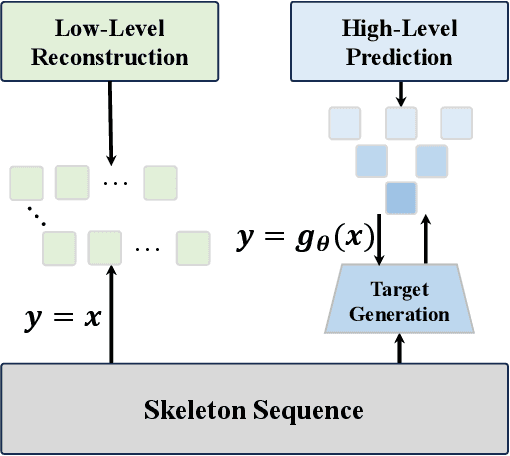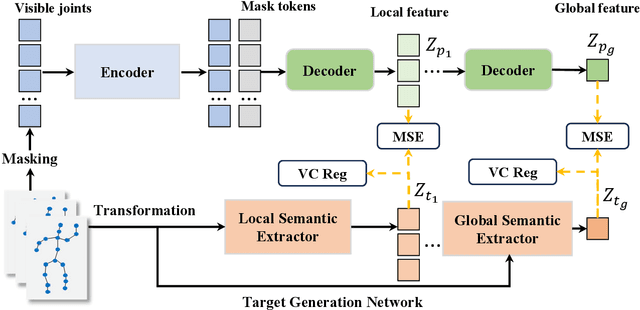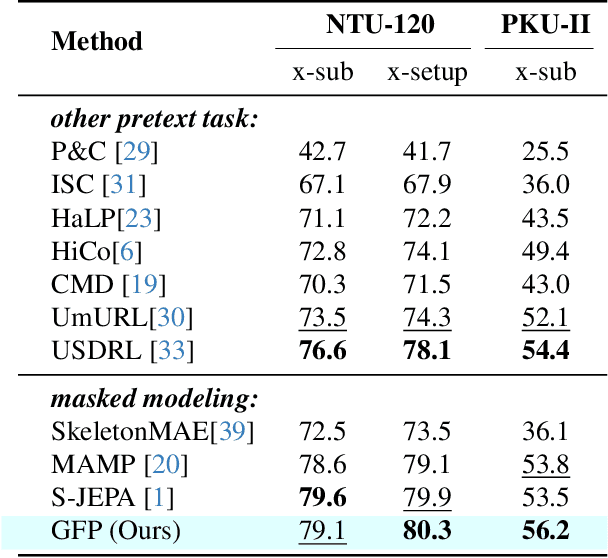Xiaojun Chang
Parallel Diffusion Solver via Residual Dirichlet Policy Optimization
Dec 28, 2025Abstract:Diffusion models (DMs) have achieved state-of-the-art generative performance but suffer from high sampling latency due to their sequential denoising nature. Existing solver-based acceleration methods often face significant image quality degradation under a low-latency budget, primarily due to accumulated truncation errors arising from the inability to capture high-curvature trajectory segments. In this paper, we propose the Ensemble Parallel Direction solver (dubbed as EPD-Solver), a novel ODE solver that mitigates these errors by incorporating multiple parallel gradient evaluations in each step. Motivated by the geometric insight that sampling trajectories are largely confined to a low-dimensional manifold, EPD-Solver leverages the Mean Value Theorem for vector-valued functions to approximate the integral solution more accurately. Importantly, since the additional gradient computations are independent, they can be fully parallelized, preserving low-latency sampling nature. We introduce a two-stage optimization framework. Initially, EPD-Solver optimizes a small set of learnable parameters via a distillation-based approach. We further propose a parameter-efficient Reinforcement Learning (RL) fine-tuning scheme that reformulates the solver as a stochastic Dirichlet policy. Unlike traditional methods that fine-tune the massive backbone, our RL approach operates strictly within the low-dimensional solver space, effectively mitigating reward hacking while enhancing performance in complex text-to-image (T2I) generation tasks. In addition, our method is flexible and can serve as a plugin (EPD-Plugin) to improve existing ODE samplers.
CARE What Fails: Contrastive Anchored-REflection for Verifiable Multimodal
Dec 22, 2025Abstract:Group-relative reinforcement learning with verifiable rewards (RLVR) often wastes the most informative data it already has the failures. When all rollouts are wrong, gradients stall; when one happens to be correct, the update usually ignores why the others are close-but-wrong, and credit can be misassigned to spurious chains. We present CARE (Contrastive Anchored REflection), a failure-centric post-training framework for multimodal reasoning that turns errors into supervision. CARE combines: (i) an anchored-contrastive objective that forms a compact subgroup around the best rollout and a set of semantically proximate hard negatives, performs within-subgroup z-score normalization with negative-only scaling, and includes an all-negative rescue to prevent zero-signal batches; and (ii) Reflection-Guided Resampling (RGR), a one-shot structured self-repair that rewrites a representative failure and re-scores it with the same verifier, converting near-misses into usable positives without any test-time reflection. CARE improves accuracy and training smoothness while explicitly increasing the share of learning signal that comes from failures. On Qwen2.5-VL-7B, CARE lifts macro-averaged accuracy by 4.6 points over GRPO across six verifiable visual-reasoning benchmarks; with Qwen3-VL-8B it reaches competitive or state-of-the-art results on MathVista and MMMU-Pro under an identical evaluation protocol.
User-Feedback-Driven Continual Adaptation for Vision-and-Language Navigation
Dec 11, 2025Abstract:Vision-and-Language Navigation (VLN) requires agents to navigate complex environments by following natural-language instructions. General Scene Adaptation for VLN (GSA-VLN) shifts the focus from zero-shot generalization to continual, environment-specific adaptation, narrowing the gap between static benchmarks and real-world deployment. However, current GSA-VLN frameworks exclude user feedback, relying solely on unsupervised adaptation from repeated environmental exposure. In practice, user feedback offers natural and valuable supervision that can significantly enhance adaptation quality. We introduce a user-feedback-driven adaptation framework that extends GSA-VLN by systematically integrating human interactions into continual learning. Our approach converts user feedback-navigation instructions and corrective signals-into high-quality, environment-aligned training data, enabling efficient and realistic adaptation. A memory-bank warm-start mechanism further reuses previously acquired environmental knowledge, mitigating cold-start degradation and ensuring stable redeployment. Experiments on the GSA-R2R benchmark show that our method consistently surpasses strong baselines such as GR-DUET, improving navigation success and path efficiency. The memory-bank warm start stabilizes early navigation and reduces performance drops after updates. Results under both continual and hybrid adaptation settings confirm the robustness and generality of our framework, demonstrating sustained improvement across diverse deployment conditions.
GLaD: Geometric Latent Distillation for Vision-Language-Action Models
Dec 10, 2025Abstract:Most existing Vision-Language-Action (VLA) models rely primarily on RGB information, while ignoring geometric cues crucial for spatial reasoning and manipulation. In this work, we introduce GLaD, a geometry-aware VLA framework that incorporates 3D geometric priors during pretraining through knowledge distillation. Rather than distilling geometric features solely into the vision encoder, we align the LLM's hidden states corresponding to visual tokens with features from a frozen geometry-aware vision transformer (VGGT), ensuring that geometric understanding is deeply integrated into the multimodal representations that drive action prediction. Pretrained on the Bridge dataset with this geometry distillation mechanism, GLaD achieves 94.1% average success rate across four LIBERO task suites, outperforming UniVLA (92.5%) which uses identical pretraining data. These results validate that geometry-aware pretraining enhances spatial reasoning and policy generalization without requiring explicit depth sensors or 3D annotations.
FusionFM: All-in-One Multi-Modal Image Fusion with Flow Matching
Nov 17, 2025Abstract:Current multi-modal image fusion methods typically rely on task-specific models, leading to high training costs and limited scalability. While generative methods provide a unified modeling perspective, they often suffer from slow inference due to the complex sampling trajectories from noise to image. To address this, we formulate image fusion as a direct probabilistic transport from source modalities to the fused image distribution, leveraging the flow matching paradigm to improve sampling efficiency and structural consistency. To mitigate the lack of high-quality fused images for supervision, we collect fusion results from multiple state-of-the-art models as priors, and employ a task-aware selection function to select the most reliable pseudo-labels for each task. We further introduce a Fusion Refiner module that employs a divide-and-conquer strategy to systematically identify, decompose, and enhance degraded components in selected pseudo-labels. For multi-task scenarios, we integrate elastic weight consolidation and experience replay mechanisms to preserve cross-task performance and enhance continual learning ability from both parameter stability and memory retention perspectives. Our approach achieves competitive performance across diverse fusion tasks, while significantly improving sampling efficiency and maintaining a lightweight model design. The code will be available at: https://github.com/Ist-Zhy/FusionFM.
EmoVerse: A MLLMs-Driven Emotion Representation Dataset for Interpretable Visual Emotion Analysis
Nov 16, 2025Abstract:Visual Emotion Analysis (VEA) aims to bridge the affective gap between visual content and human emotional responses. Despite its promise, progress in this field remains limited by the lack of open-source and interpretable datasets. Most existing studies assign a single discrete emotion label to an entire image, offering limited insight into how visual elements contribute to emotion. In this work, we introduce EmoVerse, a large-scale open-source dataset that enables interpretable visual emotion analysis through multi-layered, knowledge-graph-inspired annotations. By decomposing emotions into Background-Attribute-Subject (B-A-S) triplets and grounding each element to visual regions, EmoVerse provides word-level and subject-level emotional reasoning. With over 219k images, the dataset further includes dual annotations in Categorical Emotion States (CES) and Dimensional Emotion Space (DES), facilitating unified discrete and continuous emotion representation. A novel multi-stage pipeline ensures high annotation reliability with minimal human effort. Finally, we introduce an interpretable model that maps visual cues into DES representations and provides detailed attribution explanations. Together, the dataset, pipeline, and model form a comprehensive foundation for advancing explainable high-level emotion understanding.
Towards Efficient General Feature Prediction in Masked Skeleton Modeling
Sep 03, 2025



Abstract:Recent advances in the masked autoencoder (MAE) paradigm have significantly propelled self-supervised skeleton-based action recognition. However, most existing approaches limit reconstruction targets to raw joint coordinates or their simple variants, resulting in computational redundancy and limited semantic representation. To address this, we propose a novel General Feature Prediction framework (GFP) for efficient mask skeleton modeling. Our key innovation is replacing conventional low-level reconstruction with high-level feature prediction that spans from local motion patterns to global semantic representations. Specifically, we introduce a collaborative learning framework where a lightweight target generation network dynamically produces diversified supervision signals across spatial-temporal hierarchies, avoiding reliance on pre-computed offline features. The framework incorporates constrained optimization to ensure feature diversity while preventing model collapse. Experiments on NTU RGB+D 60, NTU RGB+D 120 and PKU-MMD demonstrate the benefits of our approach: Computational efficiency (with 6.2$\times$ faster training than standard masked skeleton modeling methods) and superior representation quality, achieving state-of-the-art performance in various downstream tasks.
MDK12-Bench: A Comprehensive Evaluation of Multimodal Large Language Models on Multidisciplinary Exams
Aug 09, 2025Abstract:Multimodal large language models (MLLMs), which integrate language and visual cues for problem-solving, are crucial for advancing artificial general intelligence (AGI). However, current benchmarks for measuring the intelligence of MLLMs suffer from limited scale, narrow coverage, and unstructured knowledge, offering only static and undifferentiated evaluations. To bridge this gap, we introduce MDK12-Bench, a large-scale multidisciplinary benchmark built from real-world K-12 exams spanning six disciplines with 141K instances and 6,225 knowledge points organized in a six-layer taxonomy. Covering five question formats with difficulty and year annotations, it enables comprehensive evaluation to capture the extent to which MLLMs perform over four dimensions: 1) difficulty levels, 2) temporal (cross-year) shifts, 3) contextual shifts, and 4) knowledge-driven reasoning. We propose a novel dynamic evaluation framework that introduces unfamiliar visual, textual, and question form shifts to challenge model generalization while improving benchmark objectivity and longevity by mitigating data contamination. We further evaluate knowledge-point reference-augmented generation (KP-RAG) to examine the role of knowledge in problem-solving. Key findings reveal limitations in current MLLMs in multiple aspects and provide guidance for enhancing model robustness, interpretability, and AI-assisted education.
Ground-R1: Incentivizing Grounded Visual Reasoning via Reinforcement Learning
May 26, 2025Abstract:Large Vision-Language Models (LVLMs) have demonstrated impressive general capabilities across a wide range of multi-modal tasks. However, the reasoning processes of LVLMs often suffer from unreliable outputs and limited interpretability. To address this, grounded visual reasoning has emerged as a promising paradigm that enforces responses anchored on salient visual evidence regions. However, existing approaches typically rely on costly supervision such as bounding box annotations, chain-of-thought rationale or external tool calls, limiting their scalability. In this work, we propose Ground-R1, a reinforcement learning framework that enables grounded visual reasoning without requiring explicit evidence or rationale annotations. Ground-R1 consists of a grounding phase that generates evidence region rollouts based on format constraints, and an answering phase that produces responses guided by both answer correctness and format adherence rewards. Extensive experiments across multiple visual reasoning benchmarks manifest that Ground-R1 achieves superior performance and exhibits emergent cognitive behaviors such as uncertainty awareness, spatial perception, and iterative refinement, offering a scalable and interpretable alternative to existing approaches.
Semantic-enhanced Co-attention Prompt Learning for Non-overlapping Cross-Domain Recommendation
May 25, 2025Abstract:Non-overlapping Cross-domain Sequential Recommendation (NCSR) is the task that focuses on domain knowledge transfer without overlapping entities. Compared with traditional Cross-domain Sequential Recommendation (CSR), NCSR poses several challenges: 1) NCSR methods often rely on explicit item IDs, overlooking semantic information among entities. 2) Existing CSR mainly relies on domain alignment for knowledge transfer, risking semantic loss during alignment. 3) Most previous studies do not consider the many-to-one characteristic, which is challenging because of the utilization of multiple source domains. Given the above challenges, we introduce the prompt learning technique for Many-to-one Non-overlapping Cross-domain Sequential Recommendation (MNCSR) and propose a Text-enhanced Co-attention Prompt Learning Paradigm (TCPLP). Specifically, we capture semantic meanings by representing items through text rather than IDs, leveraging natural language universality to facilitate cross-domain knowledge transfer. Unlike prior works that need to conduct domain alignment, we directly learn transferable domain information, where two types of prompts, i.e., domain-shared and domain-specific prompts, are devised, with a co-attention-based network for prompt encoding. Then, we develop a two-stage learning strategy, i.e., pre-train & prompt-tuning paradigm, for domain knowledge pre-learning and transferring, respectively. We conduct extensive experiments on three datasets and the experimental results demonstrate the superiority of our TCPLP. Our source codes have been publicly released.
 Add to Chrome
Add to Chrome Add to Firefox
Add to Firefox Add to Edge
Add to Edge